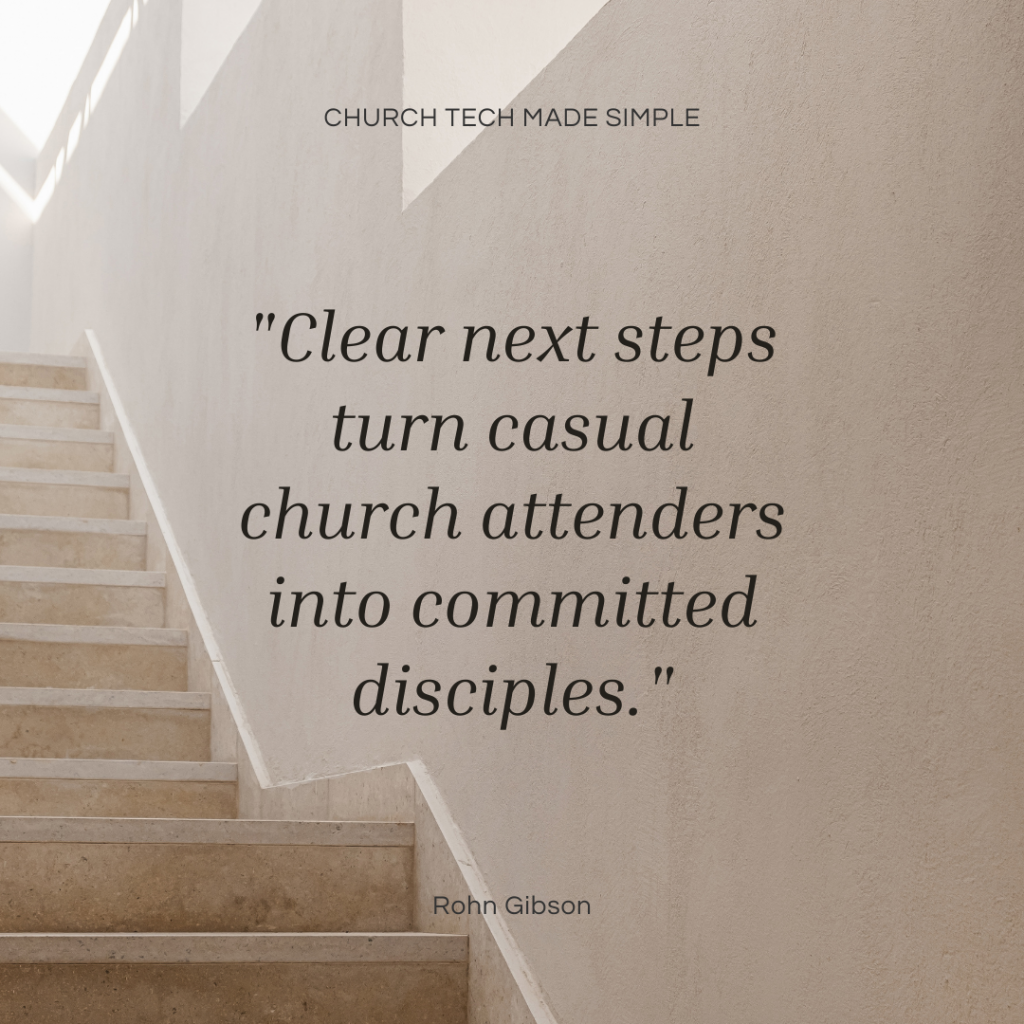How to Help People Go from Attending to Belonging
One of the biggest communication gaps in the church today isn’t what we’re saying—it’s what we’re assuming.
We assume people know what to do next. We assume visitors will figure out how to get connected. We assume our congregation knows how to move from Sunday attendance to deeper engagement.
But assumptions don’t make disciples. Clear next steps do.
If your church wants to grow—not just in size but in spiritual depth—you need a clear, visible, and simple path for people to follow. Whether it’s a first-time guest or a long-time attendee, everyone should know how to take their next step toward community, service, and spiritual growth.
This chapter is about building that pathway. We’ll cover what next steps are, why they matter, how to communicate them well, and how church tech can help you create a system that saves time and deepens connection.
“Therefore encourage one another and build one another up, just as you are doing.”
—1 Thessalonians 5:11 (ESV)
What Are “Next Steps” and Why Do They Matter?
In a church context, next steps are simple actions that help people grow in their faith and feel more connected to the church.
Next steps might include:
-
Planning a visit
-
Attending a welcome class
-
Joining a small group
-
Serving on a team
-
Getting baptized
-
Meeting with a pastor
-
Starting a Bible reading plan
These steps are how people move from watching to participating, from consuming to contributing. They turn spectators into disciples.
A clear next step strategy creates a culture of movement—and where there’s movement, there’s growth.
“But be doers of the word, and not hearers only, deceiving yourselves.”
—James 1:22 (ESV)
Why People Don’t Take Next Steps (Even When They Want To)
Here’s a hard truth: most churches aren’t lacking in opportunities. They’re lacking in clarity.
Many people in your pews would gladly take a next step if they knew:
-
What to do
-
When to do it
-
How to get started
Instead, they’re left with vague announcements, crowded bulletins, or hallway conversations that end with, “Just talk to so-and-so.”
Confusion stalls connection.
Your job as a leader is to remove friction, not add to it. Don’t make people hunt for a form, a date, or a staff contact. Don’t wait for them to ask. Be proactive. Be obvious. Be clear.
Three Essential Traits of a Good Next Ste
To be effective, every next step should be:
1. Clear
People need to know exactly what you’re asking them to do. Don’t say, “Get involved.” Say, “Join a volunteer team by filling out this form.”
2. Visible
Don’t bury your next steps in a long email or on the third slide of a Sunday announcement loop. Put them on your homepage. Say them from the platform. Include them in your church app or email footer.
3. Simple
The more steps required, the fewer people will take action. One form. One link. One button. Make it easy to say yes.
“For if the readiness is there, it is acceptable according to what a person has, not according to what he does not have.”
—2 Corinthians 8:12 (ESV)
Common Next Steps Your Church Should Offer
If you’re not sure where to start, here are the most common next steps that almost every church should offer in some form:
1. Plan a Visit
Even if people don’t fill out the form, just offering it makes your church more accessible. It removes the fear of showing up without knowing what to expect.
2. Attend a Welcome Event or Class
Give newcomers a predictable way to learn about your church. It could be a monthly lunch, a quarterly class, or a one-on-one coffee with a leader.
3. Join a Small Group or Bible Study
Make it easy for people to see what groups are available, how to join, and who to contact.
4. Start Serving
List volunteer teams clearly and create one easy way to get involved. Don’t make people navigate five different paths depending on the team.
5. Baptism and Membership
Offer a simple, repeatable process that’s explained online and from the stage. Include stories of others who’ve taken that step.
6. Submit a Prayer Request
This is one of the most powerful and underutilized steps. Make it easy for people to share a need.
How Tech Can Support the Next Step Pathway
Once your next steps are clear, church tech can help you make them consistent and time-saving.
Here are three simple ways:
1. Use Forms to Gather Info
Whether it’s a Plan Your Visit form or a volunteer sign-up, make it digital, short, and mobile-friendly.
-
Use tools like Google Forms, ChurchSpring, or your church management system (ChMS)
-
Tag or segment people based on their selection so follow-up is easy
2. Automate the Follow-Up
When someone fills out a form, don’t let the momentum stop.
-
Use automated emails or texts to thank them and explain the next step
-
Schedule a reminder for a staff member or volunteer to reach out personally
3. Track Engagement Over Time
Use your ChMS to monitor who’s taken which steps. Are people moving from visitor to group to service to giving? If not, where are they getting stuck?
This data isn’t just about numbers—it’s about stewardship. It helps you see where to invest more communication, encouragement, or support.
Building a Digital “Next Steps” Hub
Create a central page on your website labeled “Next Steps.” Use simple tiles or buttons for each option, such as:
-
I’m new here
-
I want to join a group
-
I’d like to serve
-
I’m interested in baptism
-
I need prayer
Each option should lead to a short explanation and one clear action (form, link, contact, etc.).
Promote this hub in your:
-
Weekly email footer
-
Sunday slides
-
Verbal announcements
-
Social media bio links
When people know where to go, they’re far more likely to grow.
Case Study: From Confused to Connected
A mid-sized church in the Midwest was frustrated by a lack of engagement. They offered great small groups, volunteer teams, and newcomer events—but people weren’t showing up.
After reviewing their communication, they realized everything was buried in long emails, unclear announcements, and too many separate sign-ups. They created a central “Next Steps” page on their website, simplified all forms into one universal form, and promoted one clear step each week.
In just three months, they saw:
-
An increase in small group sign-ups
-
Volunteer team growth across multiple ministries
-
Increased traffic to their website and ChMS system
People weren’t avoiding next steps—they were just confused. Clarity created movement.
“So that through the church the manifold wisdom of God might now be made known to the rulers and authorities in the heavenly places.”
—Ephesians 3:10 (ESV)
Creating a Culture of Movement
Next steps aren’t just a system. They’re a mindset. A way of leading your church to always be taking one step closer to Jesus and one step deeper into community.
Here’s how to create that culture:
1. Talk About It Constantly
From the platform, in your emails, in meetings—make it part of the language of your church.
2. Celebrate Progress
When someone joins a group or gets baptized, tell the story. Use testimony videos. Share in your newsletter. Let people see what movement looks like.
3. Remove Roadblocks
Look for points where people get stuck. Is your sign-up form too long? Are response times too slow? Are next steps hidden or unclear?
4. Equip Your Team
Make sure staff and volunteers know what the next steps are and how to point people to them.
“And let us consider how to stir up one another to love and good works.”
—Hebrews 10:24 (ESV)
Your Next Step
Take a look at your current communication:
-
Can a first-time guest easily find what to do after visiting?
-
Are there clear ways for someone to join a group or serve?
-
Does every ministry event include a follow-up opportunity?
If not, start small.
-
Choose one next step to feature each month.
-
Build or update a Next Steps page on your website.
-
Train your welcome team to ask one question: “What’s your next step?”
Final Thoughts
Discipleship doesn’t happen by accident. It happens by invitation. By direction. By simple, Spirit-led movement in the same direction over time.
Your church doesn’t need a hundred new programs. You need a clear pathway that invites people to grow—and the courage to lead them into it.
“Go therefore and make disciples of all nations…”
—Matthew 28:19 (ESV)
Clear next steps help people move from attending to belonging. From curiosity to commitment. From Sunday spectator to everyday disciple maker.
Let’s make it simple. Let’s make it clear. Let’s make it happen.
FAQs
Why is a “Next Steps” Website Page so important?
A “Next Seps” or “What to Expect” website page moves people from attending to belonging. They give clarity, direction, and opportunity for spiritual growth. Without them, visitors and members alike can get stuck as spectators instead of disciples.
Our church already offers groups and volunteer opportunities, but people aren’t joining. What’s the problem?
The issue is usually clarity, not opportunity. If people don’t know what to do, when to do it, and how to get started, they won’t take action. Simplify the process, make next steps visible, and communicate them consistently.
What’s the easiest next step we can start offering right away?
Start with a simple “Plan Your Visit” or “I’m New Here” option on your website and in announcements. It lowers the barrier for first-time guests and gives you a way to connect personally.
How can technology help us make next steps more effective?
Use digital forms for sign-ups, automate follow-ups with texts or emails, and track engagement in your church management system (ChMS). Tech doesn’t replace discipleship, but it ensures no one falls through the cracks.
How do we keep people from getting stuck after their first step?
Create a visible pathway. Don’t just invite them to one step—show what comes next. For example: Visit → Welcome Class → Join a Group → Start Serving. Make it clear, simple, and repeat it often in every channel of communication.
This blog is an adaptation of Chapter 4 from ChurchSpring Co-Founder Rohn Gibson’s new book Church Tech Made Simple, coming Fall 2025.
Related Blogs:
The Mission Comes First with Church Tech
Why Church Tech Feels So Overwhelming








